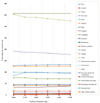1. Meneton P, Jeunemaitre X, de Wardener HE, MacGregor GA. Links between dietary salt intake, renal salt handling, blood pressure, and cardiovascular diseases. Physiol Rev. 2005; 85(2):679–715.

2. Kurosawa M, Kikuchi S, Xu J, Inaba Y. Highly salted food and mountain herbs elevate the risk for stomach cancer death in a rural area of Japan. J Gastroenterol Hepatol. 2006; 21(11):1681–1686.

3. World Health Organization. Guideline: sodium intake for adults and children. Geneva: World Health Organization;2012.
4. Ministry of Health and Welfare (KR). The Korean Nutrition Society. Dietary reference intakes for Koreans 2015. Seoul: The Korean Nutrition Society;2015.
5. Park YH, Chung SJ. A comparison of sources of sodium and potassium intake by gender, age and regions in Koreans: Korea National Health and Nutrition Examination Survey (KNHANES) 2010–2012. Korean J Community Nutr. 2016; 21(6):558–573.

6. Korea Health Promotion Foundation. Health promotion research brief 2016. The policy trends of sodium reduction and future tasks. Seoul: Korea Health Promotion Foundation;2016.
7. Ministry of Health and Welfare, Korea Centers for Disease Control and Prevention. Korea Health Statistics 2017: Korea National Health and Nutrition Examination Survey (KNHANES VII-2). Cheongju: Korea Centers for Disease Control and Prevention;2018.
8. National Health and Medical Research Council (AU). Australian Government Department of Health and Ageing. Eat for health Australian Dietary Guidelines summary. Canberra: National Health and Medical Research Council;2013.
9. Ministry of Health, Labour and Welfare (JP). About popularization of ‘healthy meal patterns’ for supporting longevity of Japanese. Tokyo: Ministry of Health, Labour and Welfare;2015.
10. Buttriss JL. The eatwell guide refreshed. Nutr Bull. 2016; 41(2):135–141.

11. Soden PM, Fletcher LR. Modifying diets to satisfy nutritional requirements using linear programming. Br J Nutr. 1992; 68(3):565–572.

12. Briend A, Darmon N, Ferguson E, Erhardt JG. Linear programming: a mathematical tool for analyzing and optimizing children's diets during the complementary feeding period. J Pediatr Gastroenterol Nutr. 2003; 36(1):12–22.

13. Ragsdale CT. Managerial decision modeling. 6th edition. Mason (OH): South-Western;2011.
14. Asano K, Yang H, Lee Y, Yoon J. Designing optimized food intake patterns for Korean adults using linear programming (I): analysis of data from the 2010 ~ 2014 Korea National Health and Nutrition Examination Survey. J Nutr Health. 2018; 51(1):73–86.
15. Ministry of Health, Labour and Welfare (JP). Report of the investigative commission for ‘Dietary Reference Intakes for Japanese (2015)’. Tokyo: Ministry of Health, Labour and Welfare;2015.
16. National Health and Medical Research Council (AU). Australian Government Department of Health and Ageing. New Zealand Ministry of Health. Nutrient Reference Values for Australia and New Zealand. Canberra: National Health and Medical Research Council;2006.
17. National Health and Medical Research Council (AU). Australian Government Department of Health and Ageing. New Zealand Ministry of Health. Australian and New Zealand nutrient reference values for sodium: a report prepared for the Australian Government Department of Health and the New Zealand Ministry of Health. Canberra: National Health and Medical Research Council;2017.
18. Institute of Medicine (US). Dietary reference intakes for water, potassium, sodium, chloride, and sulfate. Washington, D.C.: The National Academies Press;2005.
19. Maillot M, Drewnowski A. A conflict between nutritionally adequate diets and meeting the 2010 dietary guidelines for sodium. Am J Prev Med. 2012; 42(2):174–179.

20. Maillot M, Monsivais P, Drewnowski A. Food pattern modeling shows that the 2010 Dietary Guidelines for sodium and potassium cannot be met simultaneously. Nutr Res. 2013; 33(3):188–194.

21. Maillot M, Drewnowski A. Energy allowances for solid fats and added sugars in nutritionally adequate U.S. diets estimated at 17–33% by a linear programming model. J Nutr. 2011; 141(2):333–340.

22. Hur IY, Moon HK. A study on the menu patterns of residents in Kangbukgu (I): whole menu patterns and menu patterns by meal. Korean J Community Nutr. 2001; 6(4):686–702.
23. Hur IY, Moon HK. A study on the menu patterns of residents in Kangbukgu (II): compared by the sex, age and health risk. Korean J Community Nutr. 2001; 6(5):809–818.
24. Kim CH, Lee JH. The study on the consumers' perception and purchasing behavior of rice cake as a meal. Korean J Culinary Res. 2007; 13(2):59–68.
25. Moon HK, Chung HR, Cho EY. Analysis of menu patterns from the Korean National Nutrition Survey in 1990. Korean J Diet Cult. 1994; 9(3):241–250.
26. Okubo H, Sasaki S, Murakami K, Yokoyama T, Hirota N, Notsu A, et al. Designing optimal food intake patterns to achieve nutritional goals for Japanese adults through the use of linear programming optimization models. Nutr J. 2015; 14(1):57.

27. Ministry of Health, Labour and Welfare (JP). Report of the investigative commission about the way of ‘healthy meal patterns’ for supporting longevity of Japanese. Tokyo: Ministry of Health, Labour and Welfare;2014.
28. Park JH, Kim YC, Koo HS, Oh SW, Kim S, Chin HJ. Estimated amount of 24-hour urine sodium excretion is positively correlated with stomach and breast cancer prevalence in Korea. J Korean Med Sci. 2014; 29 Suppl 2:S131–S138.

29. Aburto NJ, Ziolkovska A, Hooper L, Elliott P, Cappuccio FP, Meerpohl JJ. Effect of lower sodium intake on health: systematic review and meta-analyses. BMJ. 2013; 346:f1326.

30. Mozaffarian D, Fahimi S, Singh GM, Micha R, Khatibzadeh S, Engell RE, et al. Global sodium consumption and death from cardiovascular causes. N Engl J Med. 2014; 371(7):624–634.

31. National Health and Medical Research Council (AU). A modeling system to inform the revision of the Australian guide to healthy eating. Canberra: National Health and Medical Research Council;2011.
32. Ministry of Health and Welfare (KR). The Korean Nutrition Society. Dietary reference intakes for Koreans. 1st revision. Seoul: The Korean Nutrition Society;2010.
33. Levesque S, Delisle H, Agueh V. Contribution to the development of a food guide in Benin: linear programming for the optimization of local diets. Public Health Nutr. 2015; 18(4):622–631.

34. Yeon S, Oh K, Kweon S, Hyun T. Development of a dietary fiber composition table and intakes of dietary fiber in Korea National Health and Nutrition Examination Survey (KNHANES). Korean J Community Nutr. 2016; 21(3):293–300.









 PDF
PDF ePub
ePub Citation
Citation Print
Print





 XML Download
XML Download